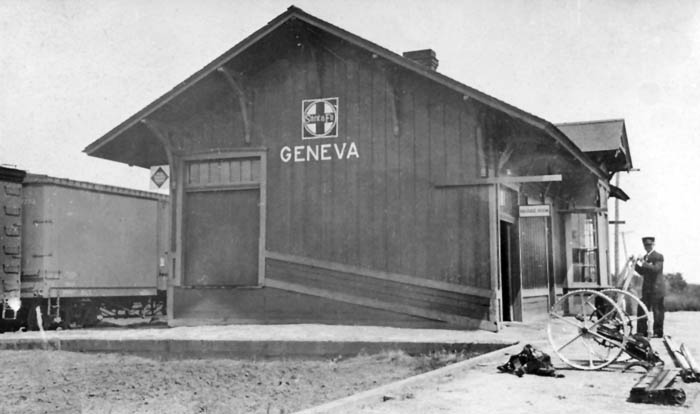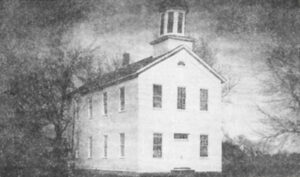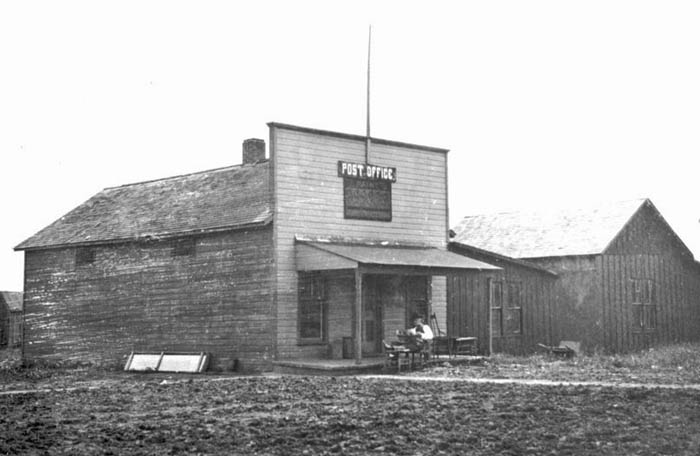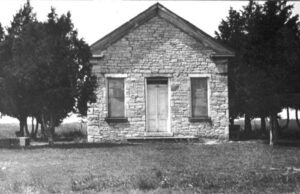Geneva, Kansas, located in northwest Allen County, was founded in Geneva Township in the summer of 1857. It is an extinct town today.
A colony was formed in New York under the leadership of Ephraim Fisk and another in Michigan under the leadership of Merritt Moore. These groups joined together to form the Union Settlement Association with prominent members including Dr. B.L.G. Stone, G.L. Wait, S.T. Jones, Reverend G.S. Northrup, I.A. Holman, P.P. Phillips, E.J. Brinkerhoff, J.H. Spicer, A.P. Sain, H.R. Somers, Frank Ureidenberg, J.C. Redfield, and J.M. Mattoon.
They selected a site north of the Neosho River between Martin and Indian Creeks, on fertile prairie land with heavy timber along the banks of the streams.
With about 300 families expected to settle, they soon began to lay out a town comprising not less than 640 acres. With plans to build a large structure to house a non-sectarian college and academy, one of their first projects was to erect a sawmill. A contract was entered into with L.L. Northrup to build the steam sawmill in exchange for 160 acres of good timber land, furnish him all the sawing he could do, and pay him $15 per thousand feet. The mill was brought and set up on the bank of Indian Creek in the summer of 1858. A post office was opened on November 13, 1858.
Because the sawing was not provided in significant quantities, L.L. Northrup soon opened a store.
Though the settlement started with bright prospects, building a large town was soon given up. Not one-fourth of the projected colony of 300 families ever came, and those who did were relatively poor. Due to the lack of money and settlement, the college was not built. However, an academy took its place afterward.
The settlers were an intelligent and enterprising class of people who regarded the moral and mental culture of the young as one of the first things to be looked to after opening their farms. Churches and schools were quickly established. The academy was built in 1866 under the charge of the Neosho Presbytery. The frame structure was two stories high.
By 1869, the town boasted two stores, a blacksmith shop, a wagon shop, a hotel, a stone Congregational Church, and an academy. The population was about 100.
Some improvements were made in the next few years, and several business enterprises were undertaken that fell through. A railroad was expected to be built through that part of the county, and when the town failed to secure it, it began to decline.
In 1880, it had Congregational and Presbyterian Churches, a district school, a general store, a hotel, a wagonmaker, a blacksmith, a grocer who was also the justice of the peace, and about 100 inhabitants. Stage coaches to Neosho Falls and Colony ran daily and delivered the mail to the postmaster, J.M. Mattoon, postmaster. Neosho Falls, four miles west, and Colony, eight miles northeast, were its shipping points. At that time, it was described as “a thriving country village.”

Atchison, Topeka & Santa Fe Railroad Depot in Geneva, Kansas, about 1905.
In the subsequent decades, the population stayed relatively the same, but Geneva did become a station on the Atchison, Topeka & Santa Fe Railroad. In 1910, it had an express office, a money order post office with one rural route, a trading center, and a shipping point for that section of the county, and it still had a population of 100.
Its post office closed on September 30, 1942. It was about ten miles northwest of Iola.
©Kathy Alexander/Legends of Kansas, updated December 2024.
Also See:
Sources:
1880 Kansas State Gazetteer and Business Directory, R. L. Polk and Company, Detroit, MI.
Blackmar, Frank W.; Kansas: A Cyclopedia of State History, Vol I; Standard Publishing Company, Chicago, IL 1912.
Cutler, William G; History of Kansas; A. T. Andreas, Chicago, IL, 1883.



